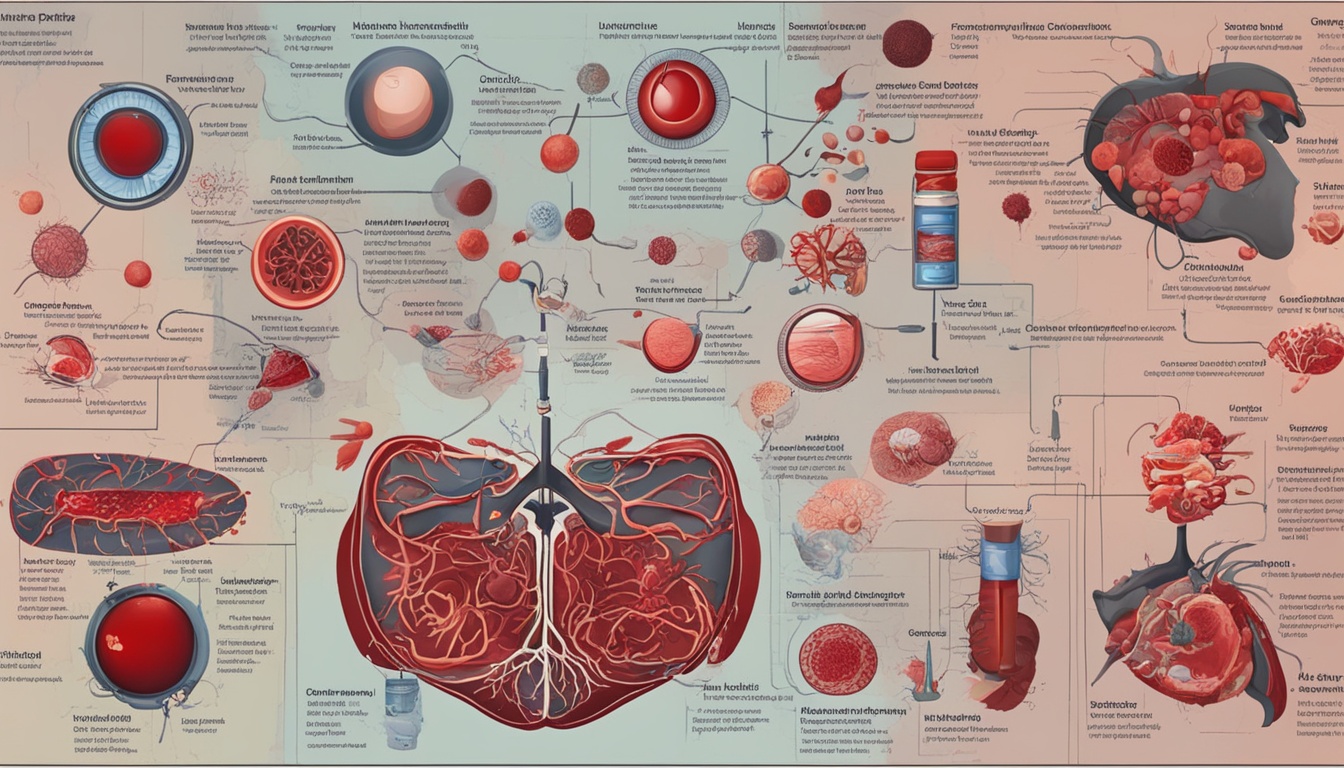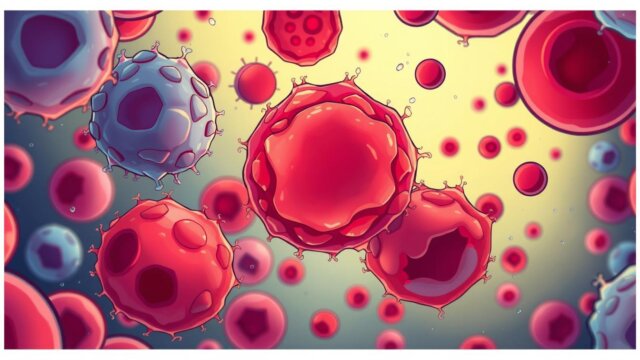FTC disclaimer: This post may contains affiliate links and we will be compensated if you click on a link and make a purchase.
About 3 million Americans have blood disorders that mess with how your blood works. These disorders can affect red blood cells, white blood cells, platelets, or the liquid plasma that carries them. Some are rare, like hemophilia in 1 in 5,000 live births. Others, like anemia, are very common and affect many people. If not treated, these disorders can cause serious problems, like too much bleeding or even life-threatening issues. It’s important to know about the types, causes, symptoms, and treatments for these conditions.
Key Takeaways
- Blood disorders are many and affect how blood works.
- Some, like anemia, are common, while others, like hemophilia, are rare.
- Not treating blood disorders can lead to serious issues, like too much bleeding or organ damage.
- Managing these disorders often means taking medicine, changing your lifestyle, and sometimes surgery.
- Getting diagnosed early and treated right is key to lessening the effects and improving health and life quality.
What are Blood Disorders?
Blood disorders cover a wide range of conditions. They affect the main parts of blood: red cells, white cells, and platelets. They can also touch the liquid part of blood, called plasma. The signs and treatments for these disorders depend on the condition and how bad it is.
Overview of Blood Disorders
Blood disorders are health issues that mess with the body’s blood system. They can come from genes, health problems, or the environment. These issues can change how red cells, white cells, platelets, or plasma work. This leads to many symptoms and problems.
Components of Blood Affected by Disorders
- Red blood cells: Carry oxygen to the body’s tissues.
- White blood cells: Fight infections and protect the body.
- Platelets: Help blood clot and heal wounds.
- Plasma: Carries the cells and proteins in blood.
Problems with these blood parts cause different blood disorders. Each has its own signs, causes, and ways to treat it.
“Blood disorders can greatly affect health and life quality. But, with the right diagnosis and treatment, many people can handle their condition and live well.”
Blood Cell Type | Function | Disorders |
|---|---|---|
Red Blood Cells | Carry oxygen to the body’s tissues | Anemia, Thalassemia, Polycythemia Vera |
White Blood Cells | Fight infections and defend the body | Lymphoma, Leukemia |
Platelets | Help blood to clot | Thrombocytopenia, Von Willebrand Disease, Hemophilia |
Plasma | Transports blood components and nutrients | Plasma Cell Myeloma |
Red Blood Cell Disorders
Red blood cells carry oxygen throughout the body. When they are affected by disorders, health issues can arise. Conditions like sickle cell anemia and thalassemia can harm these cells’ function.
Types of Anemia
Anemia happens when the body lacks enough red blood cells or they can’t carry oxygen well. There are many types, including iron deficiency anemia and pernicious anemia. Symptoms include feeling weak, tired, and short of breath.
Thalassemia
Thalassemia is a genetic disorder that affects hemoglobin production. It’s common in people from the Mediterranean region and can be mild or severe, needing blood transfusions.
Polycythemia Vera
Polycythemia vera causes too many red blood cells. This makes blood thick, raising the risk of blood clots and other problems. It can be primary or secondary, triggered by smoking or tumors.
Red Blood Cell Disorder | Description | Causes | Symptoms |
|---|---|---|---|
Iron Deficiency Anemia | Lack of iron leading to insufficient oxygen-carrying capacity of red blood cells | Low dietary iron intake, menstruation-induced blood loss | Fatigue, shortness of breath |
Pernicious Anemia | Autoimmune condition resulting in insufficient vitamin B-12 absorption | Autoimmune response | Weakness, fatigue, shortness of breath |
Aplastic Anemia | Failure to generate enough new blood cells in the bone marrow | Hepatitis, Epstein-Barr virus, HIV, certain medications, pregnancy | Fatigue, frequent infections, easy bruising |
Sickle Cell Anemia | Inherited blood disorder causing rigid, curved red blood cells | Abnormal hemoglobin production | Severe pain, organ damage |
Autoimmune Hemolytic Anemia | Immune system attacks and destroys its own red blood cells | Autoimmune response | Fatigue, jaundice, dark urine |
Polycythemia Vera | Excessive production of red blood cells leading to thickened blood | Genetic mutations, secondary causes like smoking or tumors | Headaches, dizziness, increased risk of blood clots |
“Red blood cell disorders can have a significant impact on an individual’s quality of life, but with proper diagnosis and treatment, many people are able to manage their condition and lead healthy, fulfilling lives.”
White Blood Cell Disorders
White blood cell disorders affect the cells that fight infections in our bodies. They can cause an imbalance in how these cells work. This makes people more likely to get sick and have other health problems. Lymphoma and leukemia are two common disorders.
Lymphoma
Lymphoma is a blood cancer that happens in the lymphatic system. It makes abnormal white blood cells, called lymphocytes, grow too much. This leads to tumors in lymph nodes, the spleen, or other parts of the lymphatic system. There are two main types: Hodgkin lymphoma and non-Hodgkin lymphoma, each needing different treatments.
Leukemia
Leukemia starts in the bone marrow, where blood cells are made. It makes abnormal white blood cells that take over, causing infections, anemia, and bleeding. It can be acute or chronic, depending on how fast it grows and which type of white blood cell it affects.
Other disorders include myelodysplastic syndrome and multiple myeloma. These affect how the bone marrow makes blood cells and can be serious. They need special tests and treatments to manage them.
White Blood Cell Disorder | Description |
|---|---|
Lymphoma | A type of blood cancer that develops in the lymphatic system, affecting lymphocytes. |
Leukemia | A blood cancer that originates in the bone marrow, leading to the production of abnormal white blood cells. |
Myelodysplastic Syndrome | A condition that affects the bone marrow’s ability to produce healthy blood cells. |
Multiple Myeloma | A cancer of the plasma cells, a type of white blood cell. |
“Understanding and managing white blood cell disorders is crucial for maintaining a strong and resilient immune system.”
If you think you might have a white blood cell disorder, see a doctor right away. They can diagnose and treat it. Getting help early can make a big difference in your health.
Platelet Disorders
Platelet disorders affect the cells that help blood clot. They can cause too much bleeding, abnormal clotting, and health problems. It’s important to know about these disorders to manage them well.
Thrombocytopenia
Thrombocytopenia means you have too few platelets, leading to bleeding easily. It happens to about 1 in a million people. People with this condition might bruise easily, get nosebleeds, and bleed a lot from small cuts.
Von Willebrand Disease
Von Willebrand disease makes clotting blood hard. It affects 1 in a million people, more in certain groups. Those with it might bleed a lot, especially during periods, dental work, or after injuries.
Hemophilia
Hemophilia stops blood from clotting right. It only affects boys, being an X-linked disorder. Girls can carry it but might not show symptoms. It causes bleeding that doesn’t stop and can hurt joints or muscles, needing special care.
Other disorders include heparin-induced thrombocytopenia, thrombotic thrombocytopenic purpura, and essential thrombocytosis. These affect how platelets work, causing different symptoms.
To diagnose these disorders, doctors check blood for platelet count and clotting ability. Treatment can be medicines, therapies, or surgery. Keeping up with treatment is key for staying healthy with these disorders.
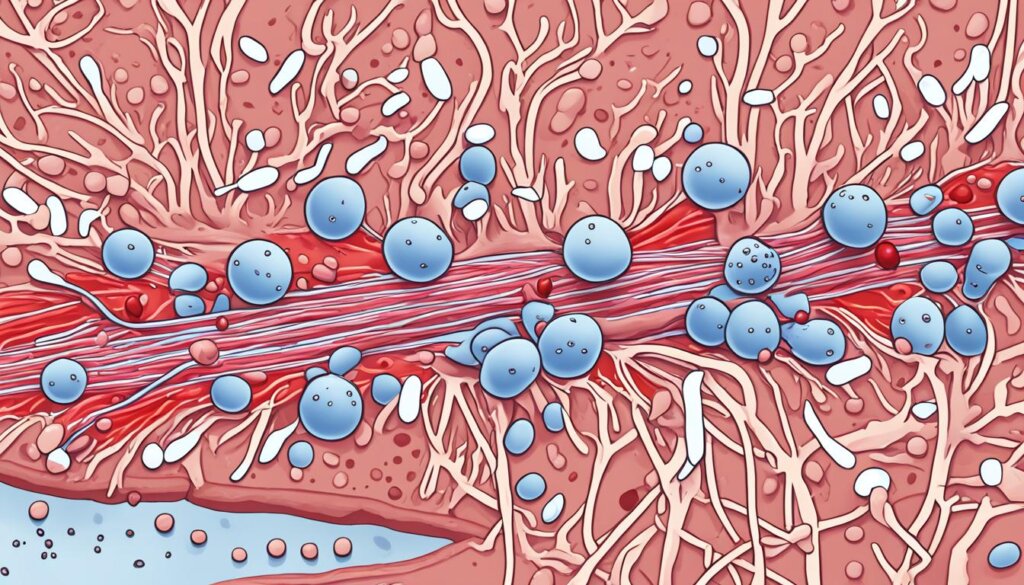
In short, platelet disorders are many and affect clotting cells. Knowing about them helps manage them better and improve health.
Plasma Cell Disorders
Plasma cell disorders affect the plasma cells, which make antibodies. They can be mild or turn into blood cancer, like plasma cell myeloma.
Plasma Cell Myeloma
Plasma cell myeloma, or multiple myeloma, is a rare blood cancer. It happens when bad plasma cells fill the bone marrow, pushing out healthy cells. This can make blood thick, harm the kidneys, and cause other problems. It’s a type of cancer that makes up about 1.8% of all new cancer cases.
Amyloidosis and monoclonal gammopathy of undetermined significance (MGUS) are other plasma cell disorders. Amyloidosis happens in about 8 to 12 people per million each year. MGUS affects around 3% of people over 40. Smoldering multiple myeloma (SMM) often turns into active multiple myeloma at a rate of about 10% a year.
Being older, male, having a family history, or being exposed to radiation can increase the risk. Doctors use blood tests, bone marrow biopsies, and imaging to diagnose these disorders.
Treatments include chemotherapy, stem cell transplants, and other drugs. These treatments can cause tiredness, bone pain, nerve problems, and anemia, among other side effects.
In summary, plasma cell disorders need careful medical attention. Knowing about their types, causes, and treatments is key to helping patients.
Causes of Blood Disorders
Blood disorders can come from many things, like genes or things outside the body. Some blood disorders are passed down in families. Others happen when the body attacks its own cells by mistake. Things like infections, some medicines, and radiation can also cause blood disorders.
Paroxysmal nocturnal hemoglobinuria (PNH) is a rare genetic disorder. It affects very few people, about one to two per million. PNH often starts in people aged 35 to 40.
Other genetic disorders include hemophilia and von Willebrand disease. These make it hard for blood to clot. Some people are more likely to get blood clots because of their genes.
Anemia is a common blood disorder with many causes. It can come from not getting enough nutrients, certain inherited conditions, or bone marrow diseases. Rare conditions like DIC and myelodysplastic syndromes can also affect blood production and clotting.

In summary, blood disorders have many causes. These include genes, autoimmune issues, infections, medicines, and radiation. Knowing the causes helps doctors treat these complex health problems.
Symptoms of Blood Disorders
Blood disorders have many symptoms, depending on the type and the blood part affected. Knowing these symptoms helps catch them early and manage them well.
Symptoms of Red Blood Cell Disorders
Red blood cell disorders, like anemia, cause fatigue, shortness of breath, and pale skin. Anemia is the most common blood disorder, with low red blood cell levels. Iron deficiency anemia is the most common type.
Symptoms of White Blood Cell Disorders
White blood cell disorders can cause frequent infections, unexplained weight loss, and feeling unwell. Leukopenia, with low white blood cells, is one condition.
Symptoms of Platelet Disorders
Platelet disorders, like thrombocytopenia and von Willebrand disease, cause easy bruising, slow-healing cuts, and nosebleeds or bleeding gums. Von Willebrand disease is the most common inherited bleeding disorder. Thrombocytopenia, a drop in platelets, can happen after cancer treatment.
Blood Disorder | Symptoms |
|---|---|
Anemia | Fatigue, shortness of breath, pale skin |
Leukopenia | Frequent infections |
Thrombocytopenia | Easy bruising, slow-healing cuts, nosebleeds |
Von Willebrand Disease | Excessive bleeding, slow clotting |
Hemophilia A | Spontaneous bleeding, joint pain |
The symptoms of blood disorders vary a lot by condition and severity. Getting quick medical help and doing tests is key for a right diagnosis and treatment.
“Early diagnosis is crucial for conditions like sickle cell disease and severe hemophilia to provide timely preventive treatment.”
Knowing the common symptoms of blood disorders helps people seek medical help early. This way, they can work better with their doctors to manage these conditions.
Diagnosis of Blood Disorders
Finding out what causes a blood disorder is key to treating it well. Doctors use many tests to find the problem and plan treatment. A key test is the complete blood count (CBC). It checks the levels of different blood cells like white, red, and platelets.
Doctors might also order tests like prothrombin time (PT), partial thromboplastin time (PTT), and international normalized ratio (INR) to check for bleeding and clotting issues. A bone marrow biopsy can also give important info on blood cell production and function.
- Hematology tests often include a Complete Blood Count (CBC). This checks White Blood Cell count (WBC), Red Blood Cell count (RBC), Platelet count, Hematocrit red blood cell volume (HCT), and Hemoglobin concentration (HB).
- These tests help diagnose anemia, blood cancers, and inflammatory diseases.
- Platelet count tests are part of CBC and help diagnose bleeding and clotting disorders.
- Tests like Prothrombin time (PT), Partial thromboplastin time (PTT), and International normalized ratio (INR) check bleeding and clotting disorders and monitor anticoagulation therapies.
- Bone marrow biopsy is not usual but hematologists use it for disease analysis.
By looking at these test results, doctors can find out what kind of blood disorder someone has. They can then make a treatment plan just for that person. Whether it’s anemia, leukemia, or thrombocytopenia, the right tests help find the cause and guide treatment.
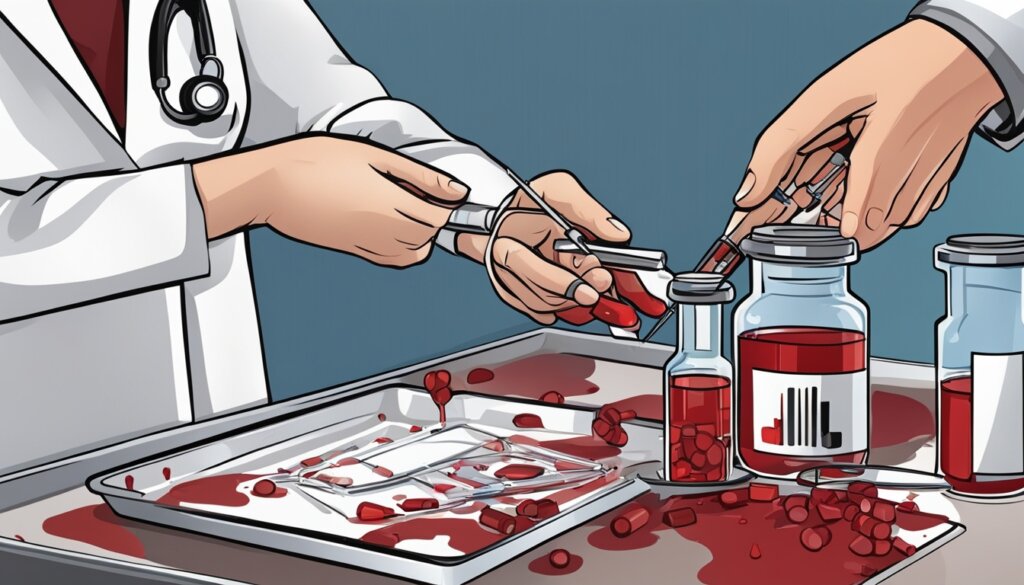
“Proper diagnosis is the first step towards effective management of blood disorders. By leveraging advanced diagnostic tools, we can uncover the root cause and develop targeted treatments that improve patients’ quality of life.”
Treatment Options for Blood Disorders
There are many ways to treat blood disorders. Doctors use medications to help make more blood cells and ease symptoms. Sometimes, surgery like blood transfusions or bone marrow transplants is needed to replace bad cells.
At places like Fred Hutch, experts treat blood cancers and other blood diseases. They make treatment plans that fit each patient’s needs. Fred Hutch has done over 17,500 bone marrow transplants, the most in the world.
Medications
Doctors use growth factors, steroids, and other medicines to treat blood disorders. These help make more blood cells, ease symptoms, and fix the disorder’s cause.
Surgical Procedures
Sometimes, surgery is needed. Blood transfusions give more blood cells. Bone marrow transplants give healthy cells to make more blood. These are done at places like Fred Hutch’s Blood and Marrow Transplant Program.
Mayo Clinic has experts in treating blood disorders with the latest tests and care. They pick the best treatment for each patient. The right treatment can vary by location, but Mayo’s team works with patients to find it.
The University of Kansas Cancer Center offers many treatments for blood disorders. They have doctors and new treatments like clinical trials and stem cell transplants. This helps patients with blood disorders get the best care.
The main goal of treating blood disorders is to fix the problem, ease symptoms, and make the patient healthier. With help from skilled doctors, people with blood disorders can find the right treatments. This improves their life quality.
Blood Disorders
Blood disorders cover many conditions that affect blood parts like red and white cells, platelets, and plasma. These issues can greatly affect health but can often be managed with treatment.
Red blood cell disorders, like anemia and thalassemia, can make it hard for the body to carry oxygen. White blood cell issues, including lymphoma, can weaken the immune system and raise infection risks. Platelet problems, such as thrombocytopenia, can cause bleeding or clotting issues. Plasma cell disorders, like plasma cell myeloma, can make it hard to produce important proteins.
Some blood disorders come from genes, while others can be caused by diseases, medicines, or lack of nutrients. Symptoms can be mild, like feeling tired or bruising easily, or severe, like organ damage or serious bleeding. Finding and treating these disorders is key to helping patients.
Researchers are always finding new ways to treat blood disorders through clinical trials and studies. By understanding these disorders and new treatments, doctors can give better care to those affected.
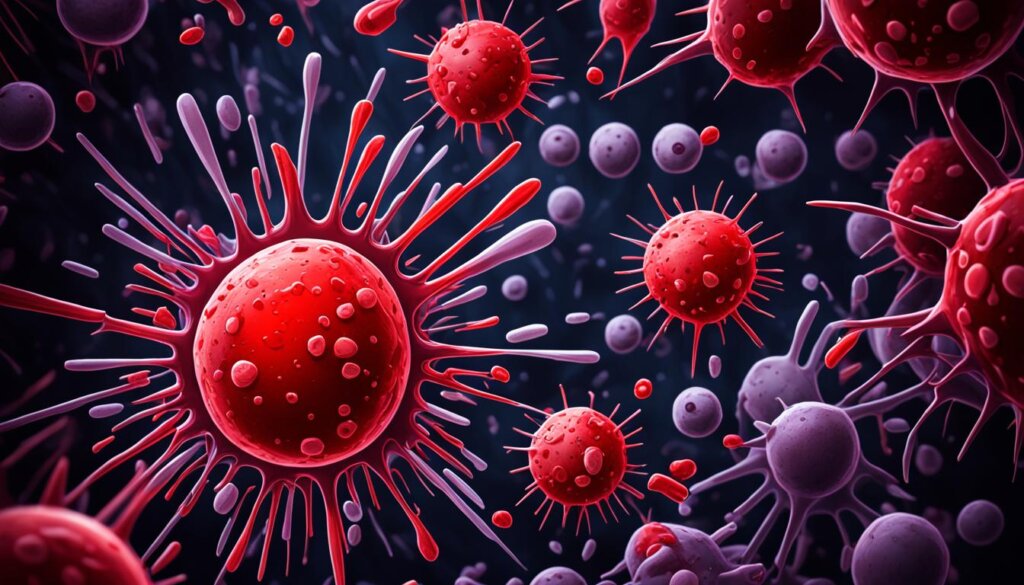
Living with Blood Disorders
Living with a blood disorder can be tough, but many people lead full lives with the right support. You might need to change your lifestyle, follow a treatment plan, and get support from loved ones and doctors.
Understanding your blood disorder is key to managing it. This knowledge helps you make smart choices about your health and work with your doctors to find the best treatment.
Lifestyle adjustments might be needed. For instance, people with von Willebrand disease or Hemophilia might avoid certain activities to prevent bleeding.
- Stay active: Exercise can prevent muscle and joint bleeds, help with posture, and boost your mood.
- Eat right: A balanced diet supports your health and helps manage your blood disorder’s symptoms.
- Manage stress: High stress can make blood disorder symptoms worse. Find ways to relax, like through hobbies or support groups.
Getting emotional support is also key. Connecting with others who understand your challenges can make you feel less alone and help you deal with your feelings.
“Living with a blood disorder can be challenging, but with the right support and management strategies, you can maintain an active, fulfilling life.”
Everyone’s experience with a blood disorder is different. It’s important to work with your healthcare team to find what works best for you. By being proactive in your care and getting the support you need, you can manage your blood disorder and live fully.
Living with a blood disorder means taking a holistic approach. This includes medical care, making lifestyle changes, and getting emotional support. By focusing on your health and happiness, you can overcome the challenges of your condition and enjoy your life.
Prevention of Blood Disorders
Some blood disorders are passed down and can’t be stopped. But, you can lower your risk of getting some by living a healthy lifestyle. Getting the right vaccines and having genetic tests if your family has blood disorders can also help.
Living a healthy lifestyle is key to preventing blood disorders. This means eating well, exercising, and keeping a healthy weight. Quitting smoking and drinking less can also lower your risk of getting blood disorders like leukemia and thrombosis.
Getting the right vaccines can also protect you from infections that might lead to blood disorders. Vaccines for flu, pneumonia, and other illnesses can cut your risk of getting anemia or thrombocytopenia.
If your family has a history of genetic blood disorders, like sickle cell disease or hemophilia, getting genetic tests is important. These tests can show your risk and help you take steps to manage or prevent the condition.
By doing these things, you can greatly lower your risk of getting many blood disorders. This helps keep your blood healthy.
Preventive Measure | Potential Benefits |
|---|---|
Healthy Lifestyle | Reduced risk of blood disorders like leukemia and thrombosis |
Recommended Vaccinations | Prevention of infections that can lead to disorders like anemia or thrombocytopenia |
Genetic Testing | Early detection and management of inherited blood disorders |
Outlook and Prognosis
The outlook for people with blood disorders varies a lot. It depends on the condition, how bad it is, and how well treatment works. Thanks to new medical care, many can live with their conditions and have full lives.
About 6 out of 10 people with aplastic anemia live more than five years after finding out they have it. For those with moderate aplastic anemia, the number goes up to 9 out of 10. People born with thalassemia can also live a long life with the right treatment, like blood transfusions and chelation therapy.
Sickle cell disease affects around 15,000 people in the UK. Thanks to new treatments, it’s easier to manage the condition. This reduces serious problems like stroke, blindness, and chest syndrome. The only cure now is a stem cell transplant. But, there are ongoing studies to find better treatments.
Myelodysplastic syndromes (MDS) are a type of bone marrow disorder. How long someone lives with it depends on the type and risk level. Survival times range from 8.8 years for low-risk MDS to just 0.8 years for high-risk MDS. New treatments, like stem cell transplants, are making things better for those with MDS.
Thanks to new treatments and better understanding, the outlook for blood disorders is getting better. By working with their doctors and managing their condition well, many people can live full lives.
Conclusion
There are many blood disorders that can really affect your health. They range from anemia 1 to serious issues like hemophilia and thrombocytopenia. Knowing about them helps in managing these complex conditions.
Thanks to new medical research and tech, doctors can now better diagnose and treat blood disorders. This means better care for people with these conditions.
Understanding blood disorders helps you watch over your health. It lets you get medical help fast and work with your doctors. You can manage your symptoms, try new treatments, or change your lifestyle to feel better.
As research and medicine get better, so does the future for people with blood disorders. By staying informed and getting the right support, you can face the challenges. You’re not alone, and with the right care, you can live a happy, healthy life.
FAQ
What are blood disorders?
Blood disorders affect the main parts of blood like red cells, white cells, and platelets. They can also affect the blood’s liquid part called plasma. These issues can really impact a person’s health and happiness.
What are the different types of blood disorders?
There are many types of blood disorders. They include:
– Red blood cell issues like anemia and thalassemia
– White blood cell problems such as lymphoma and leukemia
– Platelet issues like thrombocytopenia and von Willebrand disease
– Plasma cell disorders like plasma cell myeloma
What causes blood disorders?
Blood disorders can come from many things. These include genes, autoimmune conditions, infections, some medicines, and radiation. Some are passed down and others happen when the immune system acts too much or in response to something.
What are the symptoms of blood disorders?
Symptoms vary by the blood part affected. They can be:
– Fatigue, shortness of breath, and pale skin for red blood cell issues
– Frequent infections, losing weight, and feeling unwell due to white blood cell problems
– Easy bruising, slow healing cuts, and bleeding for platelet disorders
How are blood disorders diagnosed?
Doctors use tests to find blood disorders. These include a complete blood count and a bone marrow biopsy. These tests help figure out the type of disorder and how to treat it.
What are the treatment options for blood disorders?
Treatment can include medicines to help make more blood cells or manage symptoms. Surgery like blood transfusions or bone marrow transplants might be needed too. The treatment plan depends on the disorder’s type and how bad it is.
Can blood disorders be prevented?
Some blood disorders can’t be prevented because they’re inherited. But, you can lower your risk. This means living a healthy life, getting vaccines, and talking to a genetic counselor if there’s a family history of blood disorders.
What is the outlook for people with blood disorders?
The future for people with blood disorders varies a lot. It depends on the condition, how bad it is, and how well the treatment works. Thanks to new medical advances, many people can live with their conditions and still have fulfilling lives.
